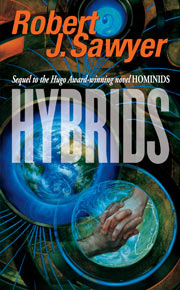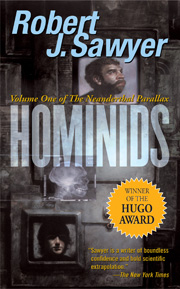Quantum computing in the Neanderthal books and real life

Robert J. Sawyer online:
Website • Facebook • Twitter • Newsgroup • Email
Labels: Hominids, Hybrids, Neanderthal Parallax
Library Journal on Wake: "Sawyer's erudition, eclecticism, and masterly storytelling make this a choice selection."

Robert J. Sawyer online:
Website • Facebook • Twitter • Newsgroup • Email
Labels: Hominids, Hybrids, Neanderthal Parallax

Everyone has heard about the asteroid that may have felled the dinosaurs, and how if it hadn't hit, we might not be here.Carolyn didn't like that much, and the next day, Friday, February 18, 2000, I completely revamped the opening:
But there have been many other asteroid impacts in Earth's past, and when this one crashed into Earth, the dinosaurs weren't yet even a twinkle in God's eye. If it hadn't hit, we would probably still be here, but they -- the others -- would not. This flying mountain, a hunk of detritus left over from the formation of the solar system that measured between one and three kilometers wide, brutally slammed into --
Into what? How to describe the rocks that bore this assault? Today, most of the world calls them the Canadian Shield, a vast horseshoe shaped region covering half the nation we refer to as Canada -- but when the impact occurred, Canada, and every other human construct, was still 1.8 billion years in the future.
Of course, in Canada, where everything would naturally be Canadian-this or Canadian-that, these rocks are sometimes called the Precambrian Shield instead, but --
But everything was Precambrian back when this colossal boulder, moving at fifteen kilometers per second, slammed into our world, setting it ringing like a giant bell in space. Although Earth had hosted life for two billion years by that point, none of it was yet multicellular. The first worms were another billion years in the future; jawless fish, the first vertebrates, were still 1.3 billion years away; and the first mammals -- ancestors to us, yes, and to them as well -- wouldn't appear for an additional three hundred million after that.
The darkness was absolute, more obsidian than Hitler's heart, darker than a rapist's soul.Of course, that lacked any character or drama. The final, published version of Hominids, which came out in 2002, began thus:
Two kilometers beneath the Earth's surface, the Sudbury Neutrino Observatory waited patiently. At its core was a vast acrylic globe twelve meters across, its walls 2.5 centimeters thick, filled with 1,100 tonnes of heavy water, on loan from Atomic Energy Canada Limited; the globe was made up of XX curved pieces each measuring XXX -- the largest size that could fit down the mine shaft leading to the observatory.
Surrounding that sphere was a geodesic of photomultiplier tubes -- 9,600 of them, each cupped in a reflective parabola, each aimed inward toward the sphere. And surrounding that was a giant barrel-shaped container, ten stories tall, filled with ultrapure regular water.
The two kilometers of Canadian shield overhead protected the heavy water from cosmic rays. The shell of regular water absorbed the natural background radiation from the uranium and thorium in the granite gabbro, preventing any of it from reaching the heavy water. Indeed, nothing at all could penetrate into the heavy water except neutrinos; trillions passed through the Earth every second, and any one of them could travel through a block of lead a light-year thick with only a fifty-percent chance of hitting anything.
Heavy water is just like regular water in taste (or lack thereof) and appearance, and it behaves virtually identically in most chemical reactions.
The blackness was absolute.You can read more of the published opening here.
Watching over it was Louise Benoît, twenty-eight, a statuesque postdoc from Montreal with a mane of thick brown hair stuffed, as required here, into a hair net. She kept her vigil in a cramped control room, buried two kilometers -- "a mile an' a quarder," as she sometimes explained for American visitors in an accent that charmed them -- beneath the Earth's surface.
The control room was next to the deck above the vast, unilluminated cavern housing the Sudbury Neutrino Observatory. Suspended in the center of that cavern was the world's largest acrylic sphere, twelve meters -- "almost fordy feet" -- across. The sphere was filled with eleven hundred tonnes of heavy water on loan from Atomic Energy of Canada Limited.
Enveloping that transparent globe was a geodesic array of stainless-steel struts, supporting 9,600 photomultiplier tubes, each cupped in a reflective parabola, each aimed in toward the sphere. All of this -- the heavy water, the acrylic globe that contained it, and the enveloping geodesic shell -- was housed in a ten-story-tall barrel-shaped cavern, excavated from the surrounding norite rock. And that gargantuan cavern was filled almost to the top with ultrapure regular water.
The two kilometers of Canadian shield overhead, Louise knew, protected the heavy water from cosmic rays. And the shell of regular water absorbed the natural background radiation from the small quantities of uranium and thorium in the surrounding rock, preventing that, too, from reaching the heavy water. Indeed, nothing could penetrate into the heavy water except neutrinos, those infinitesimal subatomic particles that were the subject of Louise's research. Trillions of neutrinos passed right through the Earth every second; in fact, a neutrino could travel through a block of lead a light-year thick with only a fifty-percent chance of hitting something.
Still, neutrinos poured out of the sun in such vast profusion that collisions did occasionally occur -- and heavy water was an ideal target for such collisions. The hydrogen nuclei in heavy water each contain a proton -- the normal constituent of a hydrogen nucleus -- plus a neutron, as well. And when a neutrino did chance to hit a neutron, the neutron decayed, releasing a proton of its own, an electron, and a flash of light that could be detected by the photomultiplier tubes.
At first, Louise's dark, arching eyebrows did not rise when she heard the neutrino-detection alarm go ping; the alarm sounded briefly about a dozen times a day, and although it was normally the most exciting thing to happen down here, it still didn't merit looking up from her copy of Cosmopolitan.
But then the alarm sounded again, and yet again, and then it stayed on, a solid, unending electric bleep like a dying man's EKG.
Robert J. Sawyer online:
Website • Facebook • Twitter • Newsgroup • Email
Labels: Hominids, Neanderthal Parallax

Visit The Robert J. Sawyer Web Site
and WakeWatchWonder.com
Labels: Hominids, Neanderthal Parallax

Visit The Robert J. Sawyer Web Site
and WakeWatchWonder.com
Labels: Hominids, Humans, Hybrids, Neanderthal Parallax, Reviews

At what point in your creative process did you decide that Wake et al., would be a trilogy? And was it the same point for your first trilogy (or 2nd) or was the first one more of the publisher's choice (as in "this is too long to publish as a single novel; let's break it up into a trilogy")?My answer is might be of interest to other writers, so I'm sharing it here:
Has your plotting evolved over time to be more aware of this sort of thing?
The Robert J. Sawyer Web Site
Labels: Far-Seer, Hominids, Neanderthal Parallax, Publishing, Wake, Writing

The Robert J. Sawyer Web Site
Labels: Hominids, Neanderthal Parallax

The Robert J. Sawyer Web Site
Labels: Flash Forward, Flashforward, Hominids, Humans, Hybrids, Neanderthal Parallax

So, yes, indeed, now is the time to take longer strides. But it's not just time for a great new American enterprise. Rather, it's time, if I may echo another speech, for black men and white men, Jews and Gentiles, Protestants and Catholics -- and Hindus and Muslims and Buddhists, and men and women of all faiths, and men and women of none -- for individuals from every one of our 191 united nations, for members of every race and religion that make up our unique, varied brand of humanity -- to go forward together, in peace and harmony, with mutual respect and friendship ... [Chapter 25]For me, it was key that the first post-Bush president acknowledge the large numbers of atheists and nonbelievers, and I'm delighted to see Obama do just that.
Four decades ago, my predecessor in the Oval Office, John F. Kennedy, said, `Now is the time to take longer strides -- time for a great new American enterprise.' I was just a kid in a Montgomery ghetto then, but I remember vividly how those words made my spine tingle ... [Chapter 5]I'm very proud of the speech I wrote for the fictitious president (the full text of which is here), but am even prouder, as an often-conflicted American-Canadian dual citizen, that my real president had the courage to acknowledge us nonbelievers in his inaugural address.
The Robert J. Sawyer Web Site
Labels: Hybrids, Neanderthal Parallax